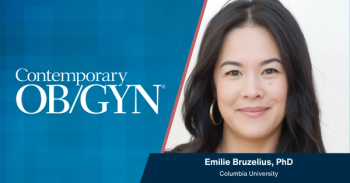
An interview with Frank Purcell, the new CEO of the American College of Nurse-Midwives (Podcast)
Editorial director Susan C. Olmstead speaks with Frank Purcell, the new CEO of the American College of Nurse-Midwives.
An interview with Frank Purcell, CEO of the American College of Nurse-Midwives
Susan Olmstead: I’m Susan Olmstead, the editorial director of Contemporary OB/GYN, and I’m speaking with Mr. Frank Purcell, the new CEO of the American College of Nurse-Midwives. Thank you for talking with us, Mr. Purcell. So, tell me, when did you become CEO? When did you take this post?
Frank Purcell: I began as CEO on the 17th of October.
Susan Olmstead: All right – so, brand-new.
Frank Purcell: Yes.
Susan Olmstead: And can you tell me – what is your background and what led to you coming into this position?
Frank Purcell: My background is about 25 years in advocacy and policy. I began my career on Capitol Hill, working with congressional staffs, and for the past 16 years, I've served at the American Association of Nurse Anesthetists in Washington to primarily address federal advocacy issues. Within the AANA, our priorities were to promote patient safety and quality improvement and advance practice. And it was my privilege to work with now some 50,000 terrific members of the AANA and to work across many coalitions and many organizations to advance that organization's objectives.
I came to the ACNM to take the CEO post here that the board has named me to, and the things really that drew me to serve with the ACNM, I think, are really three things. One is the opportunity to serve these outstanding, terrific members who've done so much for women and babies. Second, is in support of its mission, to promote care for women for a lifetime. And third, I think the thing that I also bring and enjoy is a collaborative and collegial style of work. And I believe-and I hope our members come to believe-that that's a good way to get things done, and a good way to serve to work to improve an organization, and to improve health, and to advance the objectives you hope to have.
Susan Olmstead: Now, a lot of people would find it remarkable that a man is the CEO of a nurse-midwife organization. Are you the first man in this position?
Frank Purcell: I believe so. I haven't looked that up, but I'm told that that's the case.
Susan Olmstead: All right. Now, are there any male nurse-midwives that you know of, in your group?
Frank Purcell: Yes, there are male nurse-midwives. Our board of directors includes one gentleman who is a student in midwifery and when I was interviewed by our search committee, which was headed up by the organization's treasurer and included the president and several other distinguished members of the organization, there was one gentleman who's been a midwife for quite some time.
Susan Olmstead: Now you mentioned promoting care for women for a lifetime. Is there a role for midwifery past a woman's childbearing years?
Frank Purcell: Absolutely. Nurse-midwives/midwives are educated and prepared to provide a great deal of care for women and babies during childbearing, but also for the lifetime of a woman. That's true.
Susan Olmstead: So, what sort of things would a woman past childbearing years consult with a midwife for?
Frank Purcell: That includes a good deal of well-woman primary care. And I think there are quite a number of midwives who are engaged with women in primary care, and in particular, working with women during the menopause period of their lives, and for just ensuring wellness and health. Midwives are about promoting and advancing women's health and the lives of women throughout an entire natural process, in particular from puberty through menopause. So, that's the breadth of midwifery care in the United States.
Susan Olmstead: Okay. You also mentioned advocacy. Do you see this organization as primarily an advocacy group, and what form does that take?
Frank Purcell: Midwives are always about advocacy for their patients, and for the women for whom they are providing care, and for babies. And that advocacy is while they're providing services in the care setting, that advocacy is in policy-making realms in governments, and that advocacy is in scientific and clinical realms as they seek to advance quality of care, access to care, and improvement of care for women and babies.
Susan Olmstead: And as my final question, how do you see midwives and OB/GYNs working together to help women and their babies?
Frank Purcell: I really see three levels. I think first, midwives' professional relationships with one another and with OB/GYNs in the clinical setting are absolutely critical for patient safety, for the safety of women and babies, for their access to care, and also for addressing the challenge of high healthcare costs. So, that clinical area is extremely important.
Second, at the state level, that's where a lot of critical health policy is made. One of those critical health policies is the largest payer for labor and delivery – the Medicaid program. Greater collaboration and understanding among midwives and OB/GYNs will be critical to the interests of women and babies and of better health there at the state level.
And then at the national level, there are so many areas for crucial collaboration for women and babies. I can think of patient safety and quality outcomes, inter-professional education, building relationships of trust with one another – there are so many critical policy areas, scientific areas, where improvement can be made. Where the rubber really meets the road for me, and I think for midwives, is this: the number of births in our country are expected to grow. But unfortunately, so is fetal and maternal morbidity and mortality. That is wrong, and that is preventable. And midwives and midwifery are an answer, a terrific collaboration with OB/GYNs is an answer, and if we've grown and strengthened the American College of Nurse-Midwives and its members to help meet that challenge, I think that's a success.
Susan Olmstead: Right. It sounds like that'll be one of your priorities in your tenure.
Frank Purcell: Yeah. My board-which is elected by our membership to serve and lead the ACNM-they've really directed me to work to carry out the strategic framework of the organization. And so that means we strengthen ACNM's value for our members. It means we advance and support our affiliates and states-our state organizations. It means we promote the value and role of midwifery practice in policy and in the healthcare delivery marketplace. It means we engage around the world. Midwives have been heroic in improving the health of women and babies around the globe. And it also means we grow a strategic and sustainable organization. Those are the strategic priorities of the ACNM and that's what our board of directors, our President Lisa Kane Low from Michigan, has directed me and all of us to work together to do.
Susan Olmstead: That definitely makes sense and it sounds like a tall order, but we wish you all the best in your tenure and thank you so much. Was there anything else you'd like to add?
Frank Purcell: Other than thank you, and it's been a delight.
Newsletter
Get the latest clinical updates, case studies, and expert commentary in obstetric and gynecologic care. Sign up now to stay informed.
















